Deep Looking: how to analyse a Gothic painting
Part 3: A class in spiritual art appreciation
What isn’t really remembered since the screens took over is that looking is not the same thing as seeing, and that there are different kinds of looking for different purposes. We’ve become accustomed to the kind of looking that involves quick flickering glances and constant scrolling, skimming past images without thought or attention. Many of us who are on the internet a great deal have become habituated to the kind of looking that is just surface-level “screen-looking,” trawling for data.
Though having learned it in infancy we don’t remember it, looking is really a skill that can be learned and developed. The visual intellect is gravely neglected in our time - which is odd, since we have become a culture so saturated with imagery. We are not taught the skill of looking deeply with the intellect engaged. But this can be remedied.

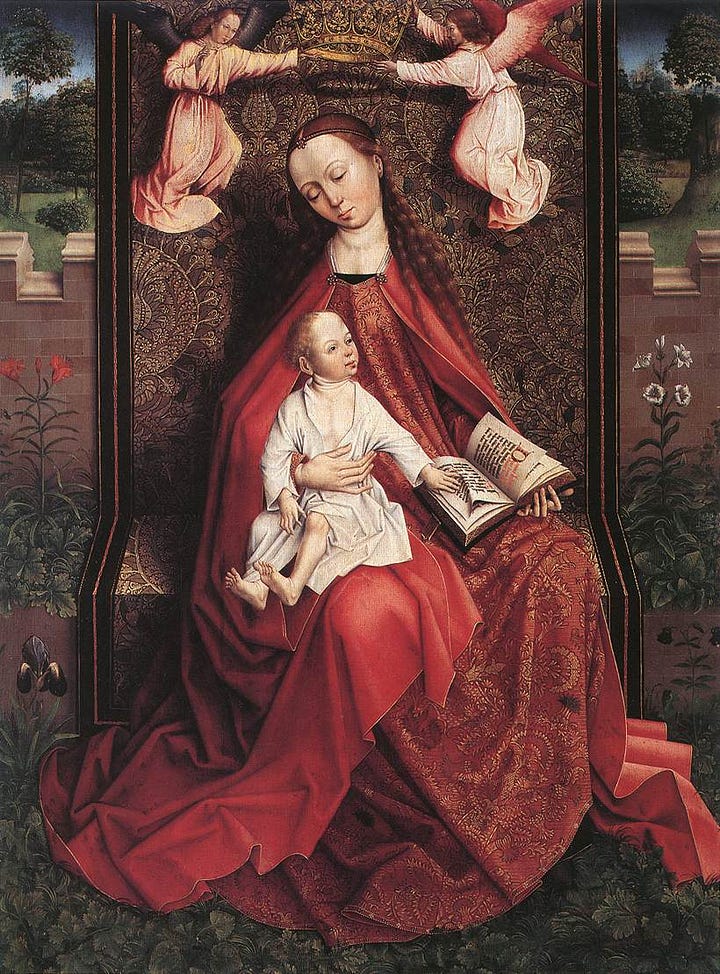
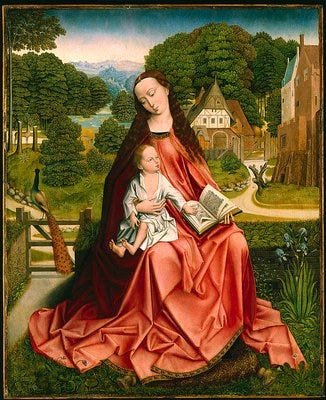

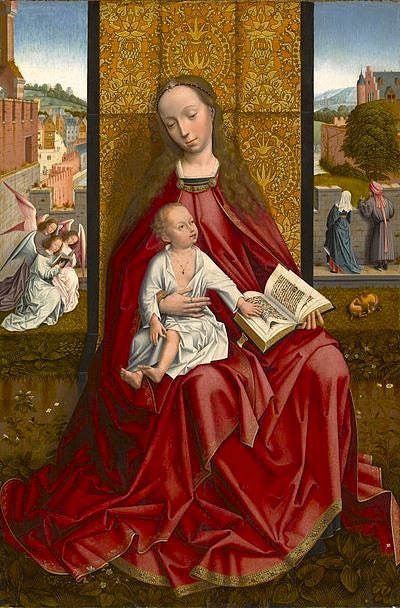
Glancing, looking and seeing
Online, we look at images mainly for utilitarian purposes, to gather data, information. And this kind of looking can become highly skilled; you can learn how to gather a lot of data from an image in a matter of a few seconds. But the kind of looking - that I call “deep looking” - really can’t happen on a screen because it’s not about the utilitarian mental actions of gathering and storing data, or satisfying intellectual curiosity. For the kind of looking that results in real seeing - that is, development of the visual intellect and the spiritual faculties that go with it - you need to be in front of the real object, and let it take time.
In today’s post for all subscribers, we’re going to think again about the concept of “deep looking” and how it fits both in spirituality and in understanding Christian sacred art. We’ll do this by making a formal analysis of a little-known Northern Gothic painting of the Madonna and Child.
Catch up with the conversation
This post is one of a long series on the concept of “deep looking” and how it affects both your mind and soul, how it is intimately connected with the development of both the spiritual and visual intellect.
~
~
The Sacred Images Project is a reader-supported publication where we talk about Christian life, thought, history and culture through the lens of the first 1200 years of sacred art. It’s my full time job, but it’s still not bringing a full time income, so I can’t yet provide all the things I want to and am planning for. You can subscribe for free to get one and a half posts a week.
For $9/month you also get the second half of the weekly Goodie Bag post, plus a weekly paywalled in-depth article on this great sacred patrimony, plus our Benedictine Book Club in the Substack Chat. There are also occasional extras like downloadable exclusive high resolution printable images, ebooks, mini-courses, videos and eventually podcasts.
If you would prefer to set up a recurring donation in an amount of your choice, or make a one-off contribution, you can do that at my studio blog. Of course, anyone setting up a monthly patronage for US $9/month or more will get a complimentary subscription to the paid section here.
This helps me a lot because the patronages through the studio blog are not subject to the 10% Substack fee:
This is the site where I post photos of my own work as it develops. I have a shop there where some of my drawings and paintings are available for sale as prints, as well as some other items.
Stop and really look
Even in a museum, where we might slow down to take in a painting, the pace is often still brisk, viewing a work of art for a few moments before moving on. And the mass-consumption that results from a walk through a large museum can be mentally overwhelming to the point where the mind simply rebels at the visual overload; the final result is a kind of mental cacophony and exhaustion. (A mistake I made once on a six-hour visit to the Chicago Art Institute; by the time we got to the last stage, the Monet room, I had to put my head down, look at the floor, and charge through in a desperate dash for the door.)
Contrast this with the profound, slow, deliberate experience of gazing at a piece of Christian sacred art, whether an icon or a Gothic altarpiece, where you go every day or every week over a period of years. In this way, icons are performing a similar function for the viewer as Scripture does for someone who practices regular Lectio Divina, the slow, repeated and meditative reading of short passages.
Over time, this “deep looking” at these sacred images draws the viewer into a contemplative dialogue with the divine, making the icon not just a work of art but a participant in the person’s interior life. Just as the scriptural passages sink into the verbal intellect, so the sacred images sink into the visual intellect, forming and guiding it. This is why the hurried viewing in a museum setting can only scratch the surface of what these images were intended to offer.
But this kind of deep looking, like Lectio Divina, takes a little instruction and practice. So I thought for today’s post for all subscribers we might enjoy going through the process of examining the painting above in a careful, thoughtful and minute way, to learn a few of these skills.
We’ve previously done an in-depth look at the Portinari Triptych here. And you can read more about the development of late Gothic painting here and here.
Late Northern Gothic: the Portinari Triptych
We’re going to take a very close look at one of the great master works of the 15th century Northern Gothic (or “early Renaissance”), the Portinari Triptych, an altarpiece of the Nativity currently held by the Uffizi Gallery in Florence.
How to look at a Gothic painting: Madonna and Child by the Master of the Embroidered Foliage

When approaching a Gothic painting, it’s essential to remember that these works were not merely aesthetic decorative objects or exercises in virtuosic artistic technique. They functioned on several levels, as vehicles for theological instruction, spiritual contemplation, and as an indication of divine presence1 a means of sanctifying the room. This analysis, rooted in the principles of traditional Christian sacred art, will guide us in understanding how the Gothic style maintained continuity with the sacred art traditions of Latin Christendom, its connections with the earlier Byzantine tradition and even as it began to incorporate elements that would later lead to the Renaissance’s later embrace of naturalism.
At first glance, this Northern Gothic depiction of the Virgin Mary and the Christ Child may seem like just a serene, devotional scene, but a careful and systematic examination reveals a rich layering of symbolic imagery, spiritual depth, and artistic intent. Paintings like this were not created solely for aesthetic pleasure but for contemplative, prayerful engagement over long periods. Every element, from the composition to the symbolic use of plants and drapery, invites the viewer into a deeper meditation on the mysteries of Christian faith.
Composition and monumentality
The figures of the Virgin and Christ are arranged in a balanced pyramidal composition, which lends the painting a sense of stability and timelessness. The Virgin’s red cloak forms the base of the pyramid, guiding the viewer’s eye upward toward her bowed head, while her posture exudes tenderness as she cradles the Christ Child and supports his hand on an open book. This triangular structure is a hallmark of Gothic monumentality, imbuing the scene with both grandeur and intimacy.
While the figures have a commanding and arresting presence, the flowing S-bend of the posture and the precise tilt of the Virgin’s head, inclined toward the Child indicating her focus on Him. The pose shows the tenderness and intimacy of their interaction and creates a delicate emotional warmth that draws the viewer into the scene.
Idealisation and sacred canons
What are “the canons”? Click here.

In keeping with Northern Gothic artistic tradition, the faces and figures are notably idealised. These are not naturalistic portraits of real people but highly constructed images, based on sacred canons - or mathematically precise rules for rendering the human figure and face - rather than direct observation of life. The Virgin Mary’s idealised beauty, with her gentle, symmetrical features, represents her as the Mother of God, pure, serene, and “full of grace”.
Similarly, the Christ Child’s face, while rendered with accurate proportions for a toddler, with a childlike innocence, carries an air of quiet and knowledgeable wisdom. In Christian theology, it is believed that Christ, even as an infant, possessed the full divine knowledge of God due to His dual nature as both fully human and fully divine. This belief was consistently depicted in art, where even as a child, Christ is often shown with a serene, wise expression, symbolizing His inherent divine knowledge and wisdom from birth. This idealisation elevates the figures beyond mere human likeness and into the realm of the divine.
Botanical symbolism and the enclosed garden
One of the most striking aspects of this painting is its detailed, naturalistic depiction of plants - a feature that earned the unknown painter the nickname, “Master of the embroidered foliage”. The Virgin is seated on a turf bench, a common feature in late medieval ornamental gardens, which creates a symbolic enclosed garden (hortus conclusus). This concept, rooted in Scripture and medieval Christian symbolism, represents Mary’s virginity and purity, drawing from the Song of Songs: “A garden enclosed is my sister, my spouse.” The enclosed garden also evokes the Garden of Eden, positioning Mary as the New Eve, whose obedience contrasts with the disobedience of the Fall.
The plants and flowers surrounding Mary are rendered with minutely accurate botanical details because they each carry specific Christian symbolism:




Strawberries symbolize righteousness and the spiritual fruitfulness of Mary’s life.
Columbines are associated with the Holy Spirit, as their flowers resemble doves - in Latin they are called “aquilegia” and are so named because they look like eagle’s talons - and they also symbolise Mary’s sorrow, pointing to Christ’s future Passion.
Daisies symbolise innocence and purity, representing both Mary and the Christ Child.
Lilies are the floral symbol we’re most familiar as associated with Mary, from depictions of the Annunciation, where they indicate her perpetual virginity.
The Gothic style of drapery
One of the easiest ways to identify a Northern or Flemish Gothic painting is the way drapery is rendered. Italian painting is known for its swirling, flowing curvilinear drapery, with very long folds. Here, the folds of Mary’s cloak are rendered in short, straight, angular lines each with a distinct terminus.
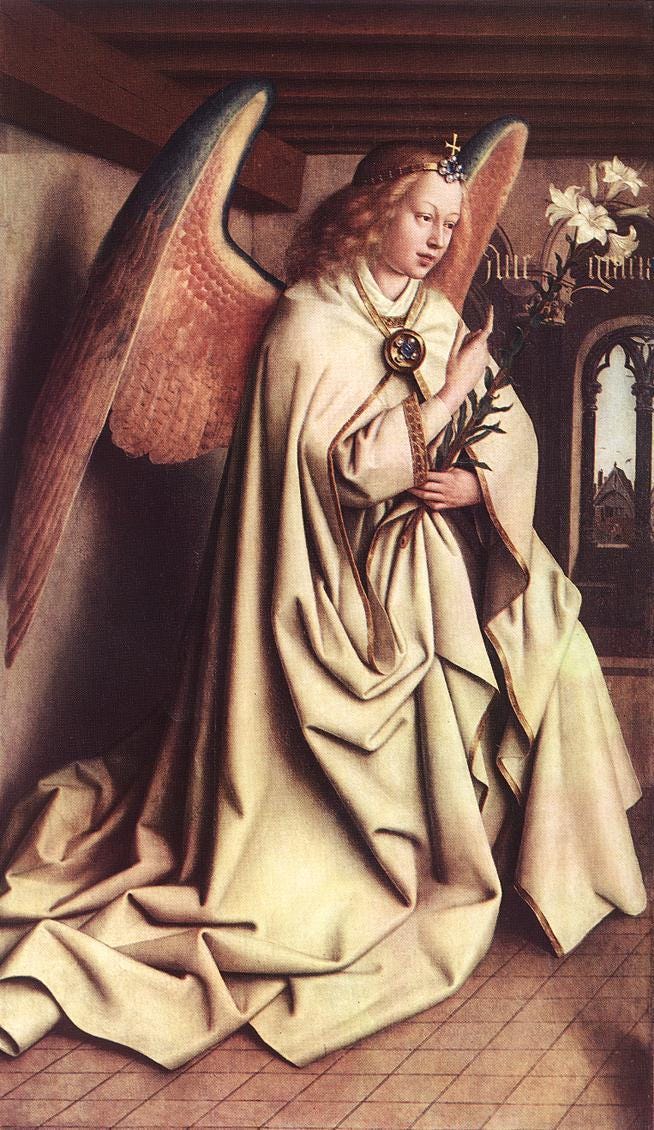
Unlike later Renaissance artists, who studied fabric and folds from life, Gothic artists followed canons when depicting drapery.

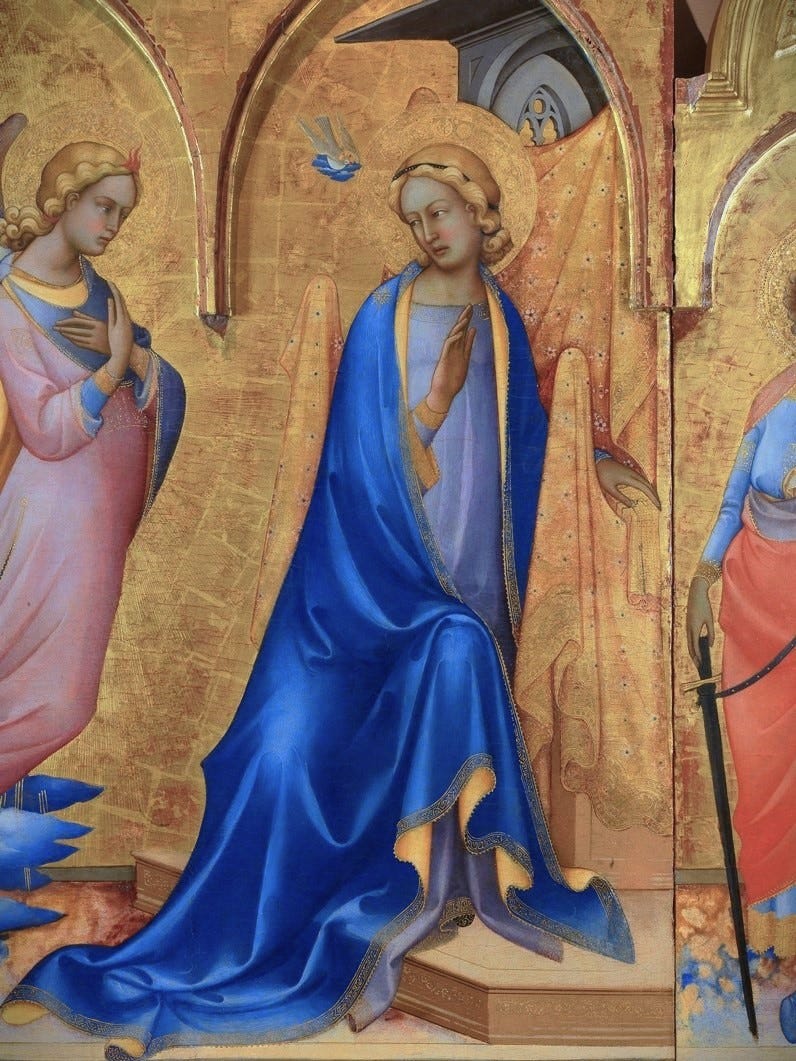
These stylised folds are not meant to imitate the natural flow of fabric but to follow a formal, idealised approach that emphasizes structure and order. The artist’s rendering of the drapery enhances the sense of monumentality, with the folds acting almost like architectural elements, framing the figures and adding to their timeless, otherworldly sacred presence.
Ethereal light and divine atmosphere

The figures and background are all bathed equally in a soft, ethereal light that lacks a specific source - this is not the glare and sharply edged cast-shadows of a sunny summer day. This diffuse illumination, typical of Gothic works, creates a serene, contemplative atmosphere and enhances the sense of idealised or perfected nature. The use of low value contrasts, with minimal differences between light and shadow, reinforces the painting’s peaceful tone, in contrast to the more dramatic lighting effects - “chiaroscuro” and tenebrism - seen in later periods.
Notably, the figures cast no shadows, an artistic decision that emphasizes their divine nature. The absence of shadows suggests that the Virgin and Christ exist in a timeless, spiritual realm, beyond the material world.
Theological symbolism of the open book
Central to the interaction between the Virgin and Christ is the open book that the Christ Child holds, with Mary gently holding it steady for Him. The book likely symbolizes the Scriptures or the Book of Life, highlighting Christ’s identity as the Word of God. Despite his infancy, Christ is depicted as embodying divine wisdom, an essential theological concept in Christian doctrine.
The open book invites the viewer to a deeper, meditative engagement, much like the practice of Lectio Divina in Christian tradition, where Scripture is read slowly and prayerfully. The book, combined with the interaction between mother and child, serves as a theological anchor for the scene, pointing to Christ’s role as both divine wisdom and human saviour.
Spiritual function and sacred space
Ultimately, this painting was designed to serve as a tool for prayerful reflection, much like an icon or Gothic altarpiece. The enclosed garden, the idealised figures, the delicate botanical symbolism, and the ethereal light all work together to create a sacred space within the painting, inviting the viewer into a contemplative encounter with the divine. The painting offers a refuge for the soul, much like the hortus conclusus itself, where the viewer can enter into the spiritual mysteries of the Incarnation.
The artist’s meticulous attention to detail, from the drapery to the botanical symbolism to the rendering of light, transforms the work from a visual object into a living, spiritual experience. The interaction between Mary and the Christ Child, set against the sacred symbolism of the garden and illuminated by a divine light, draws the viewer into a timeless dialogue with the mysteries of faith.
A non-comprehensive list of things to think about when looking at a painting
1. Basic Elements of Painting and Drawing
Line
Refers to a mark made by a brush, pen, or other tool. Lines can define shapes, create texture, and suggest movement or direction in a painting or drawing.Shape
An enclosed space defined by lines or edges. Shapes can be geometric (square, circle) or organic (irregular, freeform).Form
Refers to objects with three dimensions (height, width, depth), represented in a painting through shading, contouring, or perspective to suggest volume.Colour
The use of hues in a painting. Colour can convey mood, create harmony, or emphasize certain elements. Art historians study both the artist's palette (range of colours) and the symbolic use of colour.Value
Refers to the lightness or darkness of a colour, which helps create depth and contrast in a painting. High value contrasts can create dramatic effects.Texture
The perceived surface quality of a painting, which can be real (from thick paint layers like in impasto) or implied (illusion of texture through brushwork).Space
Refers to the sense of depth or three-dimensionality in a painting. It can be manipulated through perspective, overlapping objects, or placement of figures within the composition.Light and Shadow
The use of highlights and shadows to create the illusion of form and depth, often seen in chiaroscuro and tenebrism techniques.
2. Principles of Composition
Composition
The arrangement and organization of visual elements in a painting. It includes the balance, focus, and harmony of elements like figures, objects, and spaces.Perspective
A technique used to represent three-dimensional space on a flat surface. Linear perspective uses converging lines, while atmospheric perspective uses colour and tone to simulate depth.Balance
Refers to the visual weight of elements in a painting, which can be symmetrical, asymmetrical, or radial, creating stability or dynamic movement.Proportion
The relationship in size between different elements in a painting. Proportion can reflect reality or be exaggerated to convey symbolic meaning (e.g., hieratic scale).Focal Point
The part of a painting that draws the viewer’s attention, often achieved through colour, light, or composition.Rhythm
The repetition or alternation of elements to create movement or flow within a painting.Harmony
Refers to the cohesive arrangement of elements, where colours, lines, and shapes work together to create a pleasing, unified whole.
3. Techniques and Styles
Chiaroscuro
The contrast between light and dark to create a sense of volume and three-dimensionality. Often used for dramatic effects, especially in Baroque art.Sfumato
A painting technique that blends colours and tones seamlessly, without harsh lines, creating a smoky effect. Commonly seen in works by Leonardo da Vinci.Impasto
A technique involving thick layers of paint applied to the surface, creating texture and a sense of depth.Trompe-l'œil
A technique that creates the optical illusion that the painted objects are three-dimensional and real, literally "deceiving the eye."Alla Prima
A painting technique in which the work is completed in one session, with wet paint applied on top of wet paint (also called "wet-on-wet").Foreshortening
A technique used to create the illusion of an object or figure receding strongly into the background. It distorts proportions to suggest depth.
4. Symbolism and Meaning
Symbolic Imagery / Visual Symbolism
The study of symbols, themes, and meanings within a painting. This is particularly common in religious and mythological contexts, where objects or figures represent abstract concepts or theological ideas.Iconography
Traditionally refers to the identification and interpretation of symbols, figures, and themes in religious art. Equivalent to visual symbolism, but often used in more specialized academic contexts.Hieratic Scale
A technique where figures are depicted according to their importance, not their natural size, with more important figures appearing larger than others.Narrative
The story or message conveyed by the painting. Art historians often analyze how the painting tells a story through symbols, characters, and events.
5. Surface and Medium
Ground
The prepared surface on which a painting is executed, such as canvas, wood panel, or paper. Also refers to the base layer of a painting.Under drawing
The preliminary drawing beneath a painting, often revealed through X-ray analysis, that shows the artist’s planning or changes in composition.Brushwork
Refers to the marks left by the artist's brush on the surface of the painting. Brushwork can vary from smooth and controlled to rough and gestural.Texture
The physical or visual feel of the painting’s surface. Texture can be created through thick paint (impasto) or simulated with brush techniques to suggest materials like fabric or stone.
6. Contextual Analysis
Provenance
The history of ownership of a painting, often used to establish its authenticity, origin, and historical significance.Genre
The category of painting, such as landscape, portrait, history painting, or still life. Each genre follows its own conventions and traditions.Patronage
Refers to the individual or institution that commissioned or financed the artwork, often influencing its content or style.Historical Context
The time, place, and circumstances in which the painting was created, which often influences its themes, style, and symbolism.Cultural Influence
The impact of the broader cultural, political, or religious environment on the painting. This includes the artist's influences, the expectations of their audience, and the prevailing artistic trends of the period.
7. Techniques Related to Time Periods and Movements
Fresco
A technique of painting on wet plaster so that the paint becomes part of the wall surface. Commonly used in Renaissance and medieval wall paintings.Diptych / Triptych / Polyptych
Multi-panel paintings used in altarpieces. A diptych has two panels, a triptych three, and a polyptych more than three.Grisaille
A monochrome painting executed in shades of grey to simulate sculpture or create a decorative effect. Often used for underpainting or as a standalone piece.
8. Interpretation and Criticism
Naturalism
Refers to the depiction of figures and objects in a way that accurately mimics their appearance in the real world.Idealism
A style that emphasizes beauty and perfection, often idealizing the human figure or elements of nature beyond what is found in reality.Abstract
A style of painting that does not attempt to represent external reality, using shapes, colours, and forms to achieve its effect.Expressionism
A style where the artist conveys emotional experience rather than physical reality, often through exaggerated colours or distorted forms.
By the Gothic, western sacred art no longer functioned as Byzantine icons, as sacral objects themselves that mystically erase the distinction between heaven and earth, sanctifying the space. This had already died out in western spirituality by the Romanesque.



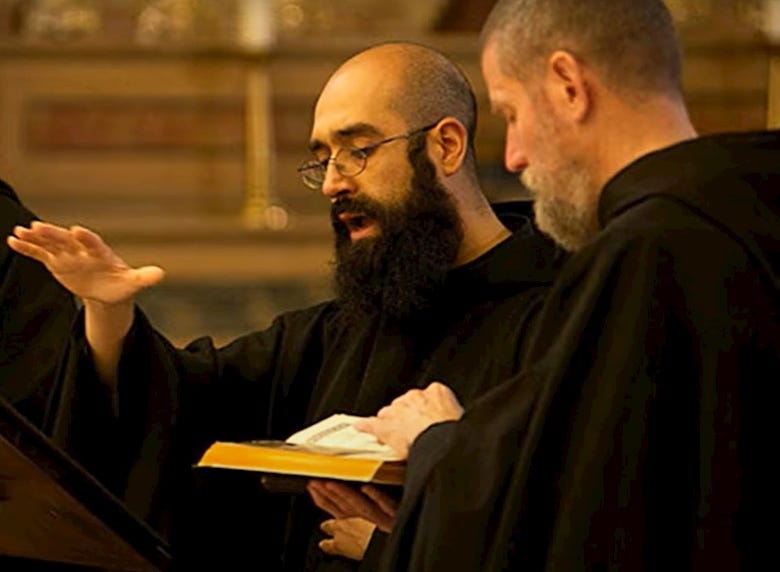
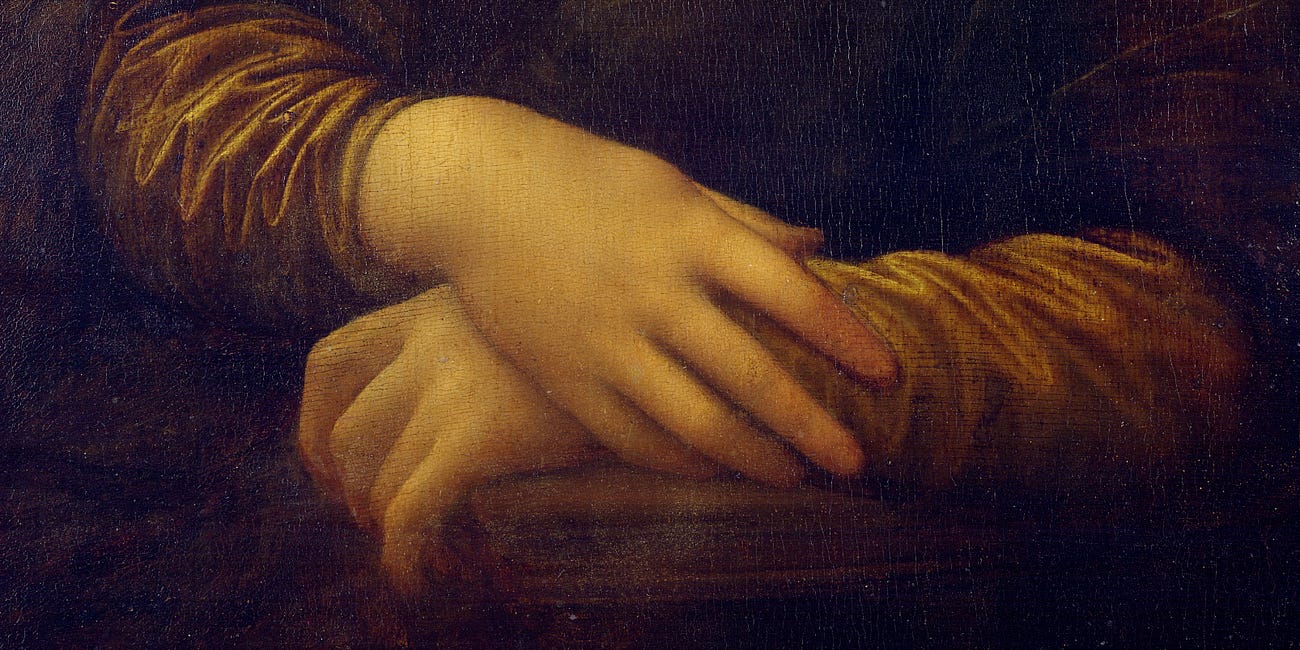




Thanks, Hilary - very helpful. I liked especially the very babyish detail in this beautiful painting of the Christ Child rumpling the pages of the book, with Our Lady steadying it. I've not seen this detail in any other depiction of Mother and Child.
Thank you, Hilary, this is superlative work.
Though not exactly bastions of tradition in other ways, university literature departments have nonetheless remained faithful to "close reading," which is our equivalent of deep looking. It was in English classes that I gained much of my ability to analyze and thoroughly comprehend visual art.